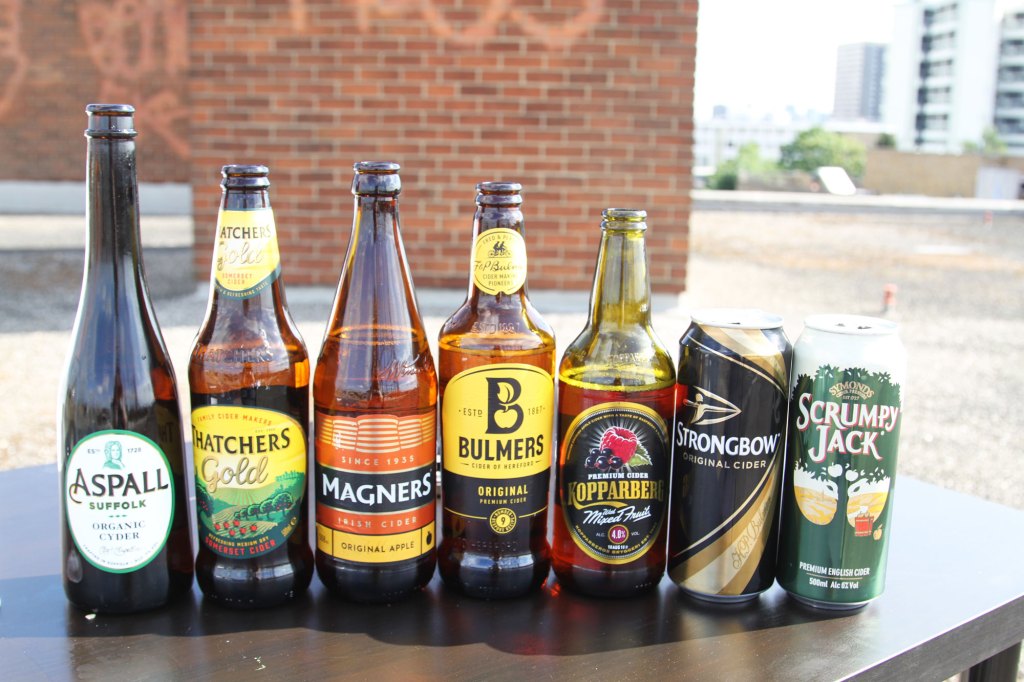This article originally appeared on MUNCHIES in June 2017.
Cider has got a bad rep. It’s the stuff you chugged in two-litre bottles at university before graduating to lukewarm tinnies at your first festival. For the duration of the summer, pub garden tables are stained with slicks of sticky Magners residue and the smell of warm Strongbow lingers in parks everywhere.
Videos by VICE
But, as fine cider connoisseur Felix Nash notes, the fermented apple beverage wasn’t always so low brow.
“My favourite description of cider is from the real heyday of cider and perry in the 1700s and 1800s from John Evelyn, a famous diarist and botanist. He described it as ‘the native wine of England,’” says Nash. “When cider is made well and properly, it’s far closer to wine than beer. You take apple juice and it turns to cider. You’re not adding heat or other ingredients. But it’s fallen so far from grace because it became so industrialised in the 1970s and 80s.”
Nash is the founder of The Fine Cider Company, a London-based business that supplies restaurants with high-end, artisan ciders from UK producers. From his office and cider store in Hackney, he explains what divides the good, the bad, and the ugly bottles.

“To call something cider in Britain, it only needs to be 35-percent apple juice. It doesn’t have to be made from cider apples and it can be from concentrate. Then it can be 65-percent water, caramels, apple flavourings, colourings. In the high-end ciders, you’re almost always looking at 100-percent cider apple juice from trees which have been carefully grafted and bred,” says Nash. “The mass-market ciders are also made in as little as three to seven weeks whereas after harvest in the autumn, the higher end stuff is usually left over winter, or for six months, nine months, a year.”
Nash usually spends his days sampling vintages from renowned fine cider makers like Tom Oliver of award-winning Oliver’s Cider and Perry, tasting nuanced blends like producer Little Pomona‘s rhubarb-y, dry Feat of Clay, and sipping single variety dessert cider from Gwatkin‘s cidery.
But, to guide you through what to pick in the pub or the cornershop when there’s none of the fancy stuff on offer, MUNCHIES invited Nash to review ciders on the lower end of the spectrum in a blind taste test. Cheers!
Scrumpy Jack
Manufacturer’s notes: “The taste of the English countryside, made entirely from locally grown bitter-sweet cider apples, including Dabinett and Chisel Jersey, creating a premium cider with a natural fruity aroma and superior crisp taste.”
Nash’s notes: “It’s pretty glowing and effervescent but in that slightly toxic, nuclear yellow way. It looks like something you could use to wash down a hazmat suit. And it’s absolute pristine clear—not a drop of dirt or dust. It’s got a nice, apple-that’s-been-soaked-in-a-swimming-pool aroma, with a little bit of acid rain to it as well. With cheaper ciders, you get a lot of monotone, flavoured apple smells.

It’s quite underwhelming on the taste. There’s some sweetness to it but there’s not actually that much to it. It gets quite cloying at the end. There’s that slight hiccup burp acidity at the end. You can feel you’re drinking something with a decent amount of water in it.”
Strongbow
Manufacturer’s notes: “Thirst-quenching apple cider for cut-through refreshment.”
Nash’s notes: “It’s got an interesting head on it, like when someone gobs and it floats on top of the liquid. It’s even lighter in colour than the first one, slightly green even.
This one is a bit more vigorous than the last. It’s got more of the hallmarks of artificial sweetener and you get that powdery sweetness across the end. It just cuts out anything else. The smell is a weird one. It’s like jelly snakes—you know the ones that are gummy on top and soft on the bottom?—that have melted in the sun. It’s the smell of burning sugar. There’s just nothing natural about it. In the middle is a plummy cherry, artificial sweetener taste and at the end, you get a foamy banana taste. “

Koppaberg Mixed Fruits
Manufacturer’s notes: “The juice of black currants and raspberries are added to our apple cider to deliver a truly unique fruity taste, rich in colour, and refreshing down to the last drop.”
Nash’s notes: “This is the alcopop domain of cider. It reminds me of Panda Pop and that mouthwash you’re given at the dentist. If you crossed Panda Pop with dental mouthwash and carbonated it, this is what you’d get.
There’s nothing about fruit or apple about it in the slightest. I think adding in flavours is an easy way for companies to say they’re being ‘innovative’ but still being really industrial. It’s harder for them to make better quality cider or to vary it. It’s easy to industrially add in different artificial flavours.
It says on the bottle, ‘We hope you enjoy this very special cider as much as we did making it for you.’ Someone obviously had a miserable time making it.”

Bulmers Original
Manufacturer’s notes: “Bulmers Original balances sweet and sharp apples, including Dabinett and Yarlington Mill varieties, home-grown in our Herefordshire orchards to produce this great tasting medium-sweet cider.”
Nash’s notes: “It’s the colour of someone who needs to drink more water and the aroma is more of a sherbet sweetness. Someone could have mixed some sugar or sweetener into boiling water and put it in the fridge to cool down.
It’s still got that fake fruit taste. It’s not like a mixed berry fruit cider and it reminds me of that strawberry toothpaste that you’d have when you were a kid. And it just drops off at the end. You don’t get much from it. It’s just artificial.”
Magners Original
Manufacturer’s notes: “Made with 17 different apples, pressed, and left for a couple of years to get extra tasty, it’s crisp, refreshing, and the best way to celebrate, well, pretty much anything.”
Nash’s notes: “It’s very peach in colour. It’s got a heavier, wilder, bit more funky nose. There’s a term used in wine but can also apply to bad ciders of “mouse,” which is when you get a smell of mouse bedding. I get that here and also a bit of nappy on this. It’s got an awkward, smoky, nappy-in-a-house-full-of-cigarette-smoke smell. Is this on the Magners side of things?
I think of how things taste quite visually, like how a cider moves up and down, from when you first taste it to when you finish it. This is just a plank. There’s a little nod to the bittersweet side of stuff and something a bit more funky about it. But, at the same time, it’s so constrained and dull.”
Thatchers Gold
Manufacturer’s notes: “Made using traditional techniques and expertise gained since 1904, this crafted medium dry cider has a smooth and refreshing taste.”

Nash’s notes: “The viscosity of it is a bit like engine oil. You get that strange petrochemical luminescent glow. This one is a bit wilder on the nose, a bit on the nappy side, and has a weird gooseberry bit as well.
It’s more acidic and a bit more cloying towards the end. You’re left with little spots of bitterness in the mouth. It leaves a thin film of petrochemical deposit on the inside of your mouth. It’s disappointing.”
Aspall Organic Cyder
Manufacturer’s notes: “Chewy and earthy with a rustic quality, and an extra astringency from the tannins.”
Nash’s notes: “It’s slightly smoky on the nose like the smell of sulphur you get when you strike a match.
It’s got high acidity. The fruit is more on the dessert apple end of the spectrum, rather than the cider apple end. That’s why it’s sharper and more acidic, and less tannic. Is this Aspall? I’d rate Aspall as the best of the ciders produced on a bigger scale. It’s the least unpalatable.”

Felix Nash is the founder of The Fine Cider Company . In 2016, he was a finalist in the “Alcohol” category at The Young British Foodie Awards— an annual celebration of the chefs, bakers, food writers, bartenders, and others advancing UK food and drink.
Entries for the 2017 YBFs are now open, with MUNCHIES’ own Phoebe Hurst judging the Food Sharing category. Head to The YBFs website to nominate someone you think deserves recognition for their contribution to British food—or go all out and enter yourself. Entries close on 30 July 2017.
More
From VICE
-

Bean Box -

Collage by VICE -

Collage by VICE -

(Photo by Kevin Winter/Getty Images for AFI)
